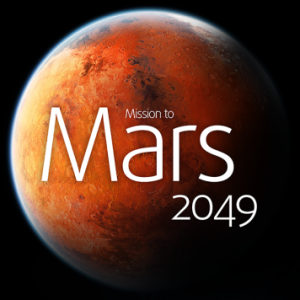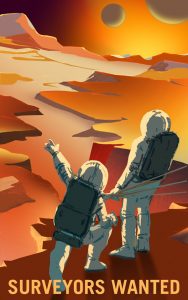Presque coup sur coup, voici quatre grosses boites ocres et carrées qui nous proposent de partir pour la planète rouge.
Je suis assez fier de Mission Planète Rouge, jeu de majorité fourbe et dynamique conçu avec Bruno Cathala, initialement paru en 2005 et dont une nouvelle version vient d’être publiée.
En plus costaud, je viens de découvrir le sérieux mais passionnant Terraforming Mars, jeu de gestion, de développement et de draft d’un nouvel auteur, Jacob Fryxellius. J’attends avec curiosité First Martians, un jeu coopératif et hybride du talentueux Ignacy Trzewiczek, qui reprend en partie les mécanismes de son Robinson Crusoë. Martians, A Story of Civilization, de deux autres polonais, Grzegorz Okilinski et Krzysztof Wolicki, a l’air bien plus costaud, mais également très intéressant. Dix minutes sur le boardgamegeek montrent qu’il en arrive quelques autres, comme Mission to Mars 2049 ou Surviving Mars, desquels je ne sais pas grand-chose.




Les quatre jeux martiens dont on parle


Et deux, un peu hasard, parmi ceux dont on parle moins.
Le fond de l’air est donc rouge, passablement frais, et manque un peu d’oxygène.
Domaine réservé d’un certain sérieux scientifique, le plus souvent sans le moindre fantastique, la conquête de Mars a une place un peu à part en marge de la littérature de science-fiction. On retrouve ce sérieux dans l’esthétique sobre et très réaliste de la plupart des jeux martiens. Mission: Planète Rouge est le seul où l’éditeur ait choisi de se distinguer par un look steampunk, et par un peu d’humour, tout en restant dans les tons ocres et orangés. L’action est censé se dérouler en 1888, mais les prototypes de Bruno et moi la situaient plutôt, comme pour tous les autres jeux cités plus haut, vers 2050.


 Trois images de la planète Mars, toujours dans les tons ocres.
Trois images de la planète Mars, toujours dans les tons ocres.
Tout cela n’est pas entièrement nouveau, et il y a déjà eu quelques bons jeux sur le thème de la découverte et, surtout, de l’exploitation et de la colonisation de Mars, mais je ne pense pas qu’il y en ait jamais eu autant publiés en même temps. Comment peut-on expliquer cet engouement soudain pour la planète rouge ?


Deux jeux plus anciens auxquels je me souviens avoir joué.
On peut d’abord chercher des explications du côté de la littérature et du cinéma. Lorsque, dans les années 2000, Bruno Cathala et moi travaillions à Mission : Planète Rouge, nous nous étions un peu documentés en lisant les textes les plus classiques de la littérature martienne. Voici ce que j’en avais alors écrit dans ma présentation du jeu :
« Puisque nous partions du thème, et voulions être réalistes, je décidais de me documenter un peu. Je commençais par quelques visites sur les sites web, fort nombreux, consacrés à la planète rouge et à divers projets de colonisation plus ou moins farfelus. Alors que je n’avais plus guère lu de science-fiction depuis bien longtemps, je me procurais aussi deux séries qui étaient souvent citées comme des classiques de la “littérature martienne” – Red Mars, Blue Mars et Green Mars de Kim Stanley Robinson, et Mars et Return to Mars de Ben Bova.


La volumineuse saga de Kim Stanley Robinson est généralement louée pour son réalisme, pour le sérieux de son arrière-plan scientifique. Étant assez ignare en ce domaine, je ne suis pas vraiment capable d’en juger, mais la lecture donne en effet l’impression que l’auteur s’est bien documenté sur les aspects techniques de son sujet. C’est malheureusement tout ce que l’on peut trouver au crédit de ces pavés lourds, ennuyeux et d’une incroyable prétention. S’il n’y avait que les aspects techniques, cela passerait encore, mais ils sont mis au service d’une espèce de socio-politique de bazar, un salmigondis de théories mal digérées, une sorte d’écolo-marxisme qui finit dans un délire messianique, et est asséné tout au long des trois tomes avec un imperturbable sérieux.
Les deux tomes de Ben Bova sont moins prétentieux, ce qui les rend déjà plus sympathiques, mais n’apportent pas grand-chose non plus à la littérature. C’est en effet l’archétype du roman politiquement correct, formaté avec soin pour les familles américaines. C’est une sorte de scénario de télé-réalité, avec un casting minutieusement étudié pour représenter favorablement toutes les minorités, et des participants à la psychologhie suffisamment primaire pour qu’aucun lecteur ne risque de se trouver intimidé. Au crédit de l’auteur, on notera quand même un style agréable, un tiers-mondisme sympathique mais qui aurait pu être plus subtil, et une intrigue habilement menée.
Je me suis forcé à finir ces deux sagas, mais la littérature de science-fiction “sérieuse” sur l’exploration ou la colonisation de Mars m’a semblé bien lourde et didactique. On est très loin aussi bien de l’humour de Frederic Brown que de la poésie de Ray Bradbury, mais les ouvrages de ces derniers ne nous auraient sans doute été d’aucune utilité pour réaliser ce jeu. »


Depuis, bien sûr, il y a eu en 2014 le succès retentissant du petit roman Seul sur Mars et du film qui en a très rapidement été tiré. Suite à un accident, un astronaute s’y retrouve naufragé sur la planète rouge, et, bricolage après bricolage, parvient à y survivre en attendant les secours. Tout le charme du roman d’Andy Weir vient de ce que, tout en étant plus léger et moins ambitieux que les pavés cités plus haut, il n’en était pas moins bien écrit, sérieusement documenté et relativement réaliste. L’adaptation cinématographique à grand spectacle par Ridley Scott perd bien sûr en légèreté, mais elle est efficace et restitue bien la tension de l’histoire.
Il est fort probable que les auteurs des jeux martiens qui paraissent l’un après l’autre ces jours-ci ont été inspirés par le film ou le roman – un décalage de deux ans correspond plus ou moins au temps qu’il faut pour imaginer, développer et publier un jeu. Du coup, je m’étonne qu’aucun jeu ne reprenne plus clairement l’intrigue du Martien. On imagine bien en effet un jeu de communication restreinte, dans lequel l’un des joueurs, seul sur Mars, devrait parvenir à communiquer par quelques rares indices avec les autres qui, restés sur terre, cherchent à lui envoyer des secours. On peut aussi imaginer quelque chose comme Not Alone, en version coopérative.
Il y a d’autres explications possibles à l’engouement actuel des auteurs de jeux de société pour Mars. les nouveaux projets spatiaux américains, notamment le SLS qui devrait relancer l’exploration du système solaire, à commencer par Mars, font parler d’eux, et la NASA elle même tente d’intéresser le grand public à ses projets. Je ne dis pas que l’agence est derriére la parution de ces jeux, mais il y a quelque pqrt une équipe qui travaille à populariser la conquête de Mars, et leur travail commence à porter ses fruits.
La planète rouge permet aussi d’imaginer la colonisation d’une véritable terra nullius, contournant ainsi les ambiguïtés historiques et politiques parfois reprochées aux jeux de colonisation, à une époque où le politiquement correct commence à se faire sentir, pour le meilleur et pour le pire, dans les thèmes ludiques. J’avais déjà rapidement évoqué cette idée dans mon article sur « décoloniser Catan ». Ce n’est pas un hasard si First Martians reprend certains systèmes de Robinson Crusoë.
Quoi qu’il en soit, il semble que nous n’ayons pas fini d’explorer, terraformer, coloniser et développer Mars dans les mois qui viennent – et si tous ces jeux sont aussi bons que Terraforming Mars, c’est tant mieux.
There’s something about Mars, with four square and ocre game boxes published almost simultaneously.
I’m quite proud of Mission Red Planet, a tricky and eventful majority game designed with Bruno Cathala, a new edition of which has just been published.
I’ve just played my first game of something much more serious, the outstanding Terraforming Mars, a management and development game by a newcomer, Jacob Fryxellius. I’m very curious of the upcoming First Martians, a hybrid cooperative game designed by the talentuous Ignacy Trzewiczek using the same basic engine as his Robinson Crusoe. Martians, A Story of Civilization, by Grzegorz Okilinski et Krzysztof Wolicki, looks like much heavier stuff, but I’ve heard really good things about it. In ten minutes browsing the Boardgamegeek, I found half a dozen more coming, like Mission to Mars 2049 or Surviving Mars, of which I know nothing.




The four Martian games everyone is talking about.


Two of the many other ones.
Looks like the air is fresh, red and lacking in oxygen.
In science-fiction literature, the exploration and colonization of Mars is a very specific topic, the place for relatively hard science, serious and realistic, with little room for fantasy. This also shows in the realistic and sober graphics of most martian games. Mission: red Planet is the only one for which the publisher opted for a steampunk style, and some humor. The action is supposed to take place in an alternate late nineteenth century, but Bruno and I originally had in mind the middle of the twenty-first one, like in the other games.


 Three visions of Mars – usually ocher, circular and flat.
Three visions of Mars – usually ocher, circular and flat.
This is not entirely new. There has already been a few good games about exploring, mining and colonizing Mars, but I don’t think there has ever been that many published in a short time. How can we explain this sudden enthusiasm for the red planet?


Two older games I remember playing.
We can first look at literature and movies. When, in the early 2000s, Bruno Cathala and I were working on Mission: Red Planet, we dutifully read the classics in Martian literature. Here’s what I have written then when discussing the game’s design process:
“Since we started with the theme, and wanted to make something realistic, I decided to look for some serious documentation. I first browsed some of the many websites devoted to Mars exploration and to some more or less zany colonization projects. I had not read any science fiction book for quite long and ordered the two series that were most often quoted as classics of “martian litterature”, Red Mars, Blue Mars and Green Mars by Kim Stanley Robinson, and Mars and Return to Mars by Ben Bova.


Kim Robinson’s saga is often praised for its realism, for its serious scientific background. I’m not competent in this matter, and therefore cannot really judge it on this, but at least it feels as if the author seriously studied the technical aspects of the question. That’s the only positive thing for these long, heavy and pretentious tomes. Unfortunately, Kim Robinson’s technical competence is used as a support for a political hodgepodge, a mish mash of ill-digested social theories, a kind of ecolo-marxism that ends in a delirious messianism, which is regularly and systematically forced upon the reader with boring and unruffled seriousness.
Being far less pretentious, the two tomes of ben Bova make for a more pleasant reading, but this Martian TV reality show adds little to litterature. It is a well written politically correct novel, carefully formatted for US families. Like in a reality show, the casting is designed to give a positive picture of all minorities, and the psychology of the characters simple enough to prevent any reader to be intimidated. The author can however be given credit for his clear style, for his nice, if not always subtle, third-world support, and for a well-designed plot.
I forced myself to read these sagas till the end, and my overall impression is that the literature about exploring and colonizing Mars is heavy and didactic. All this was far from the humorous wit of Frederic Brown od the poetic subtleness of Ray Bradbury, whose books could unfortunately not be of any help in designing this kind of game.“


This was in 2005. Since then, there has been a major hit in Martian literature, Andy Weir’s thriller The Martian, and the movie Ridley Scott’s made out of it. After a dramatic accident in a temporary space station, an astronaut ends stranded on Mars and manages to survive long enough, the MacGyver’s way, for a rescue mission. The novel was an unexpected hit, mostly because it was much lighter and unassuming than the heavy tomes I’ve listed before, but nevertheless well written, seriously documented and very realistic. The spectacular movie loses much of the lightness from the book, but compensates with suspense and tension.
Most of the Martian games published now were certainly inspired by the novel and/or the movie, a two years delay being more or less what’s required to design, playtest and publish a game. Surprisingly, none of these games is based on the core intrigue of the Martian – the lone astronaut stranded on the planet and trying to communicate with the earth. This could have made for a great game of restrained communication, something like a cooperative version of Not Alone.
There might be other reasons for the recent flow of Martian boardgames. The new US space projects, and specifically the SLS, aim at starting a new wave of exploration of the solar system, starting with Mars, and the NASA has tried to raise some public interest for this. I’m not saying the space agency is behind the publication of these boardgames, only that there must be somewhere a small team working at popularizing the conquest of Mars, and their work is starting to pay off.
Political correctness, for better and for worse, is also starting to be a strong issue with game settings, and the Red Planet is a place where we can imagine the colonization and development of a real terra nullius, thus avoiding political ambiguities of colonization games with historical settings. I already discussed this a bit in my “Postcolonial Catan” article a few years ago. One should not be surprised that First Martians recycles some systems from Robinson Crusoe.
Anyway, it looks like we’ll spend many game nights, in the coming months, exploring, terraforming, colonizing and developing Mars. And if all the upcoming games are as good as Terraforming Mars, this will be for the best.









